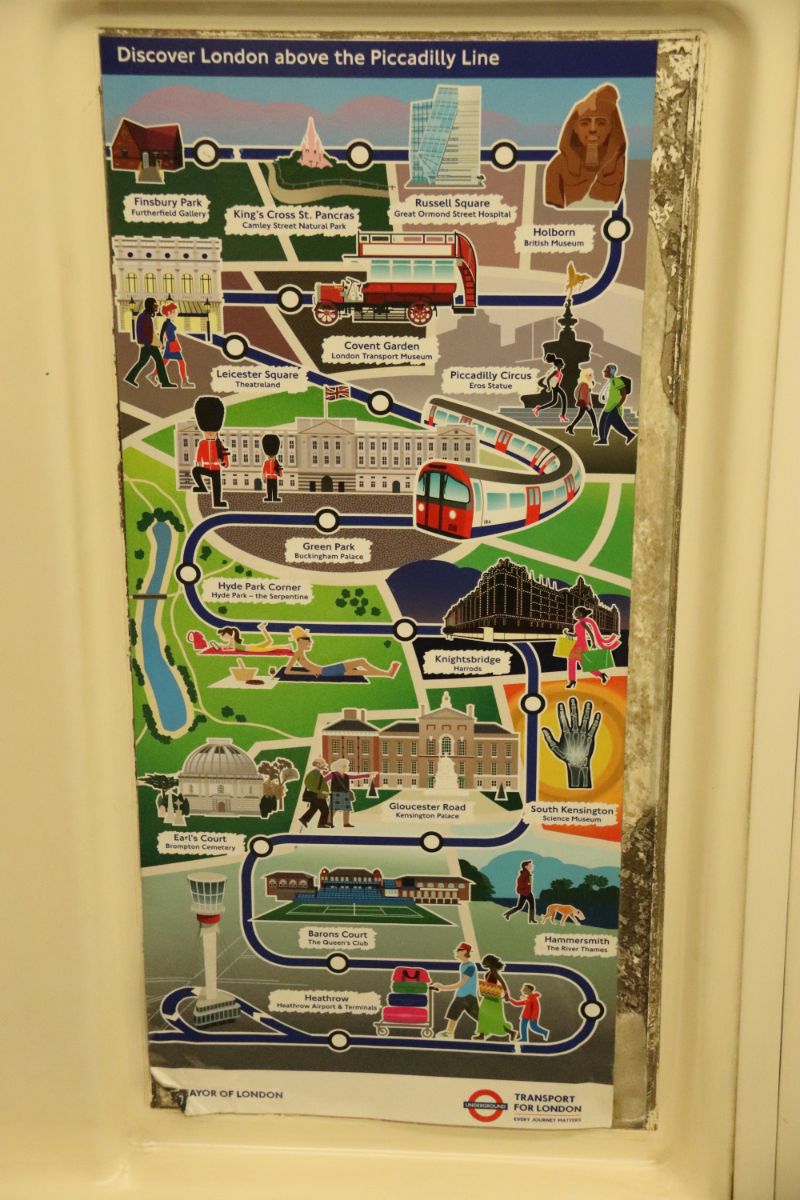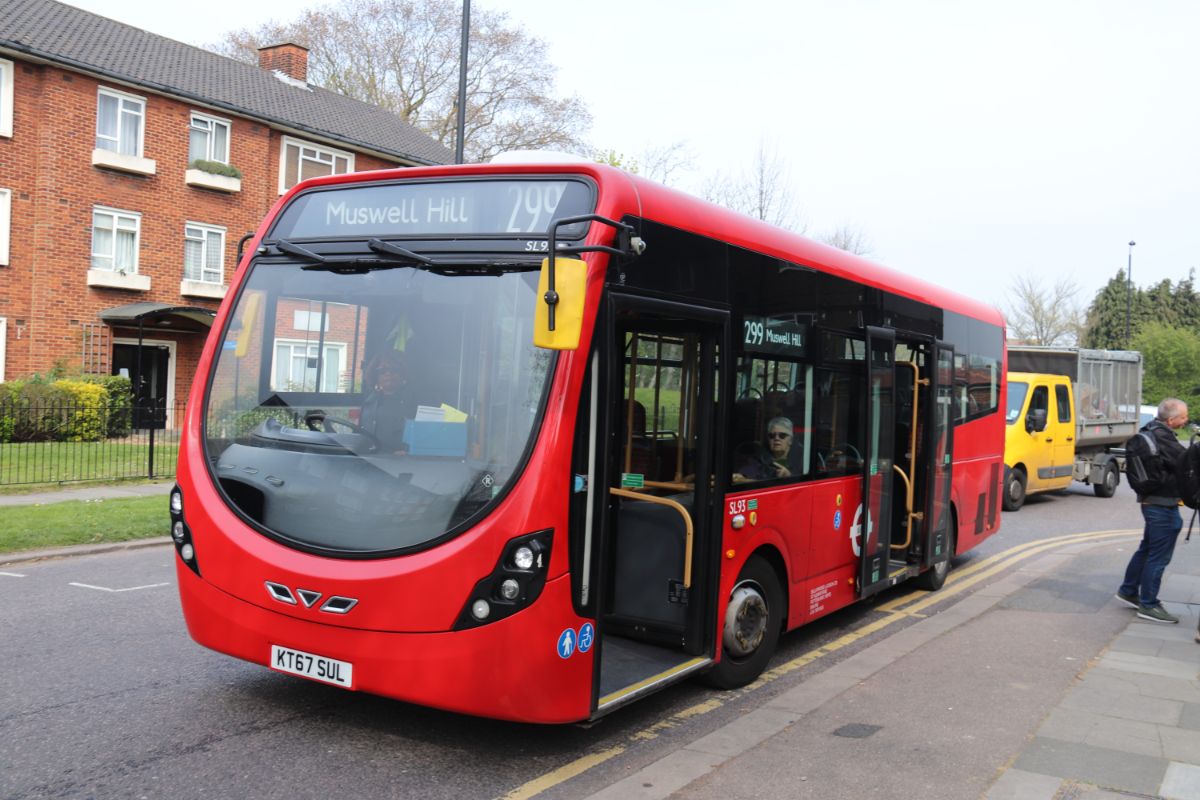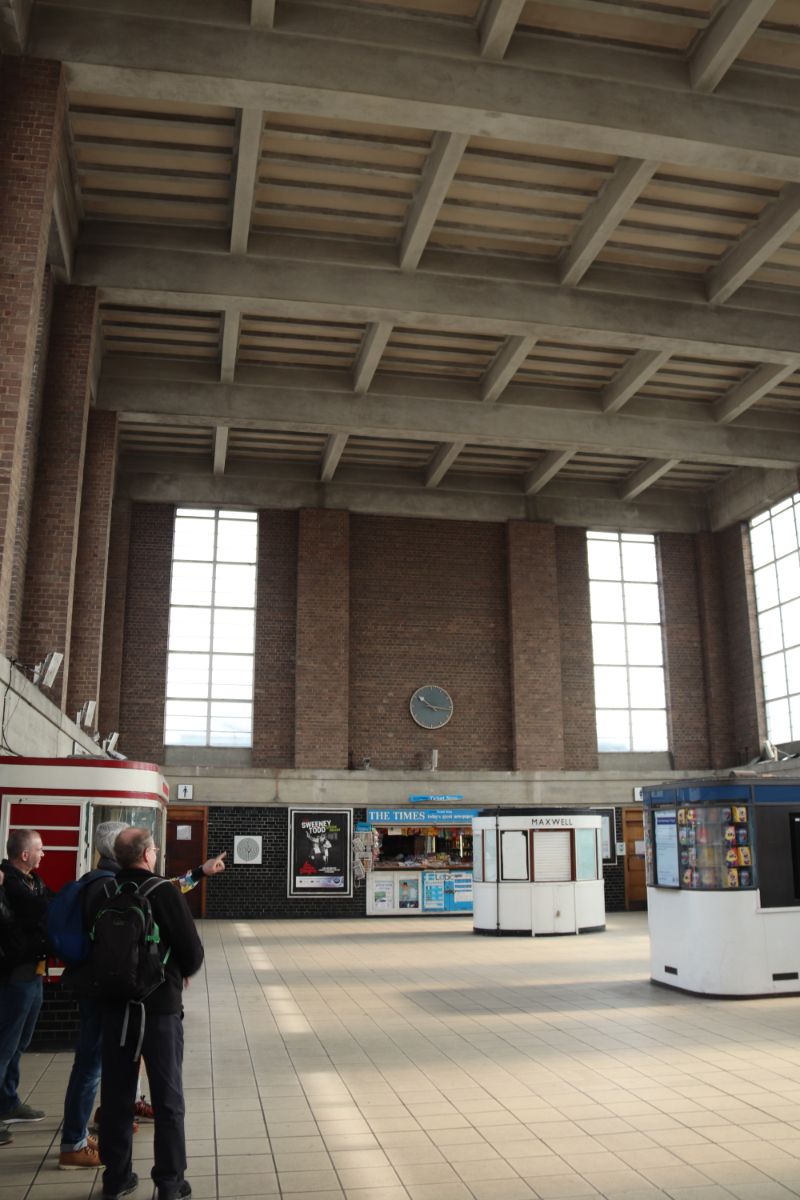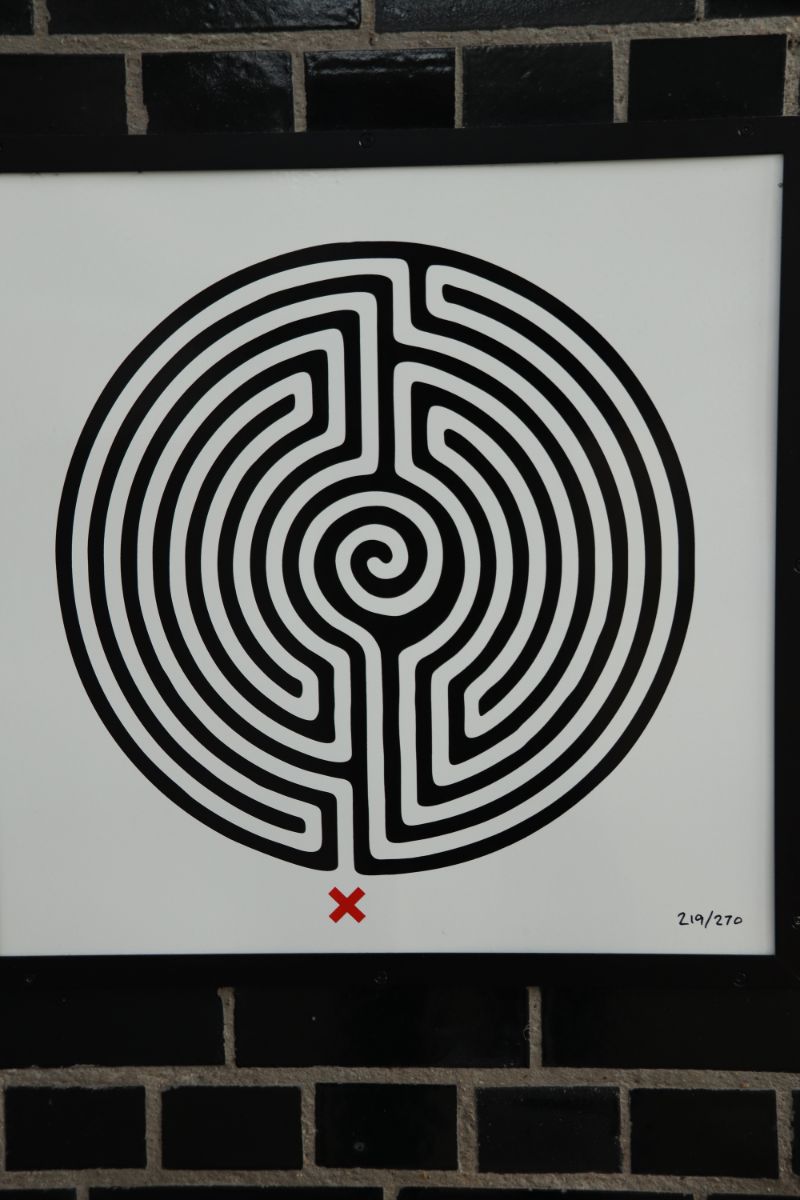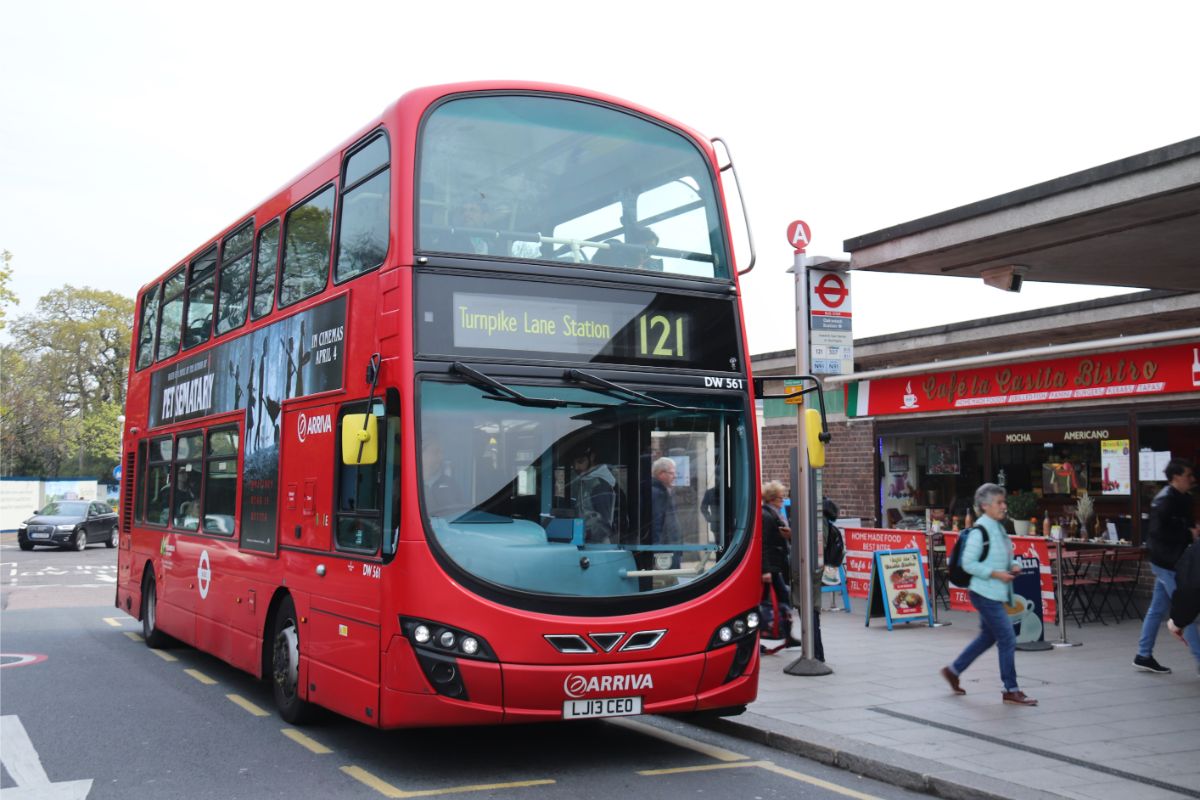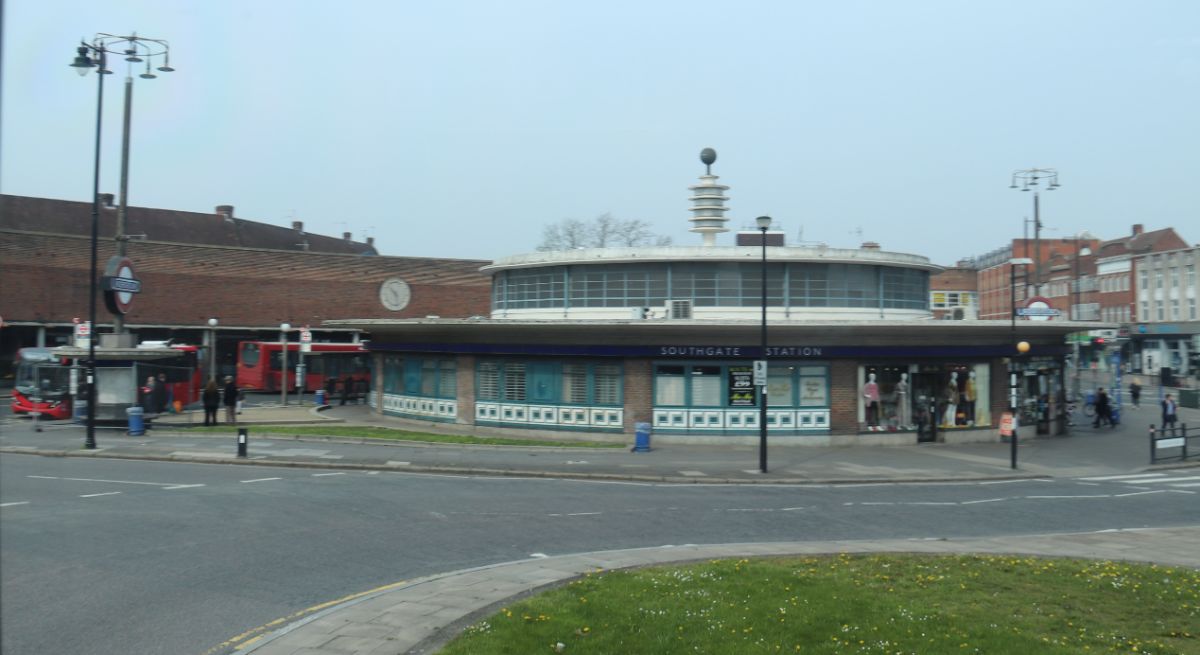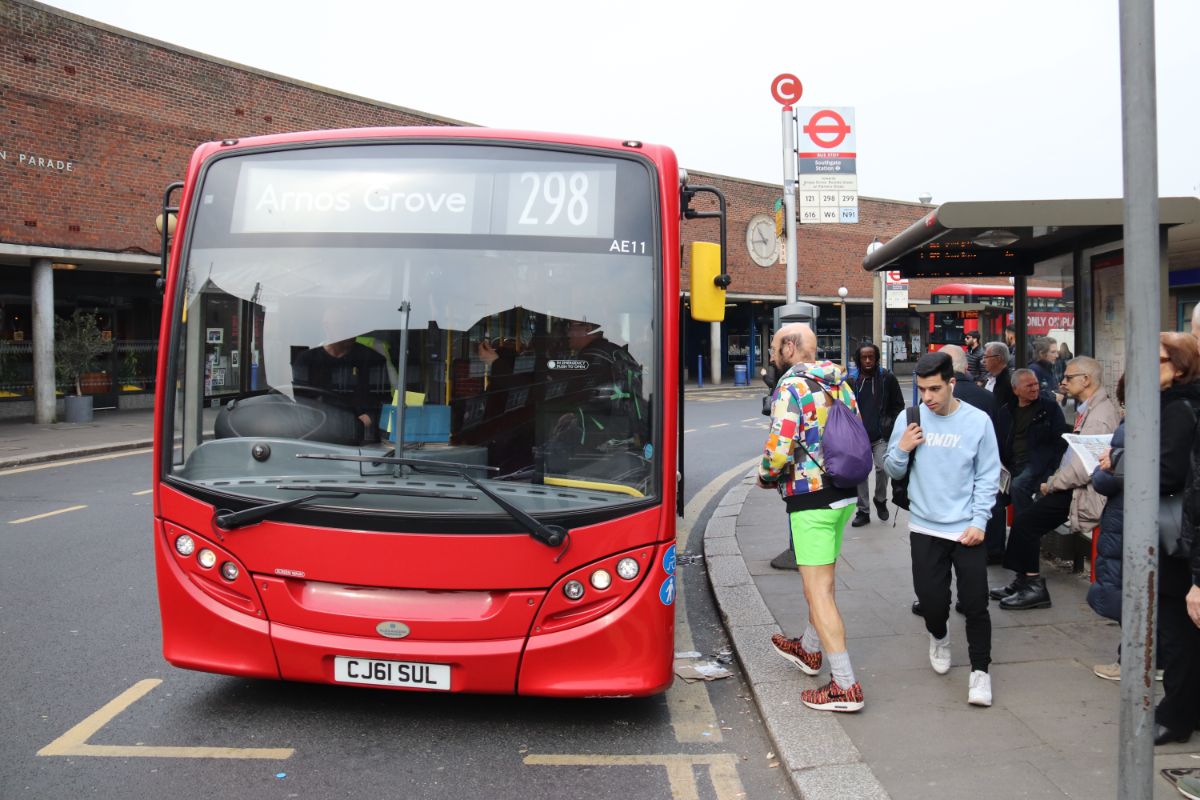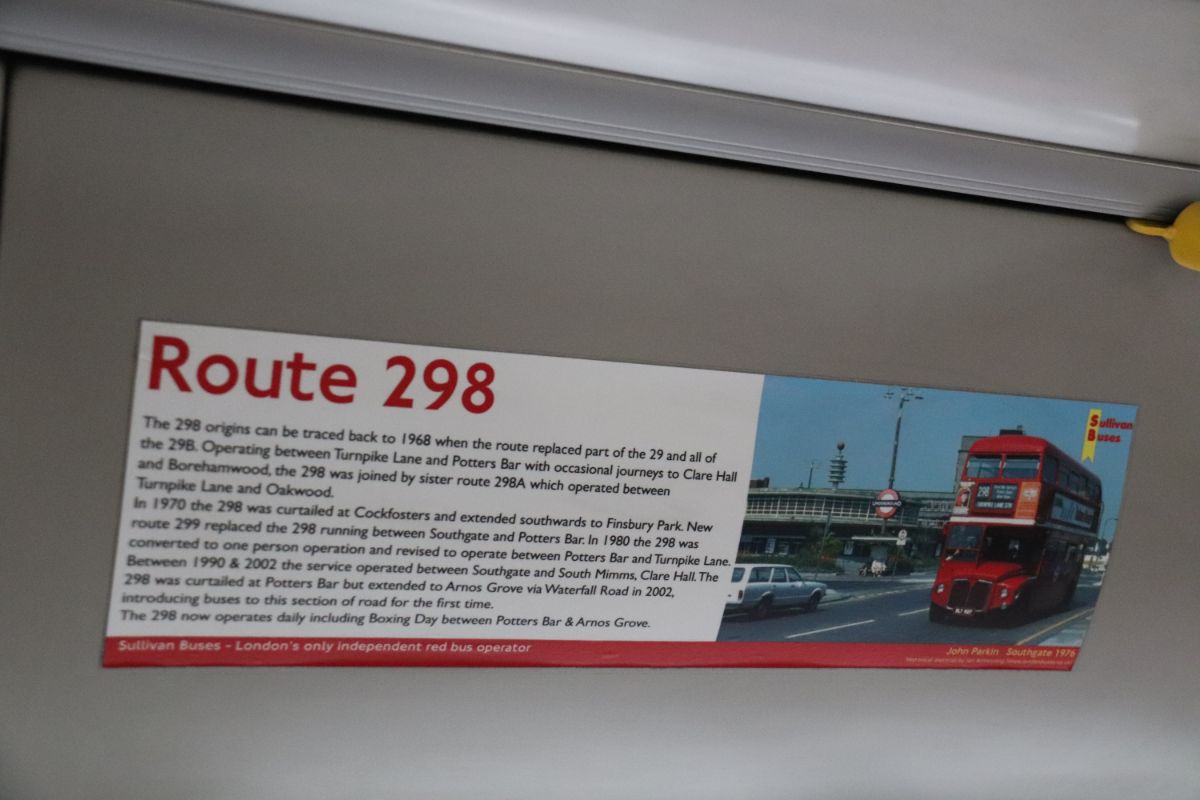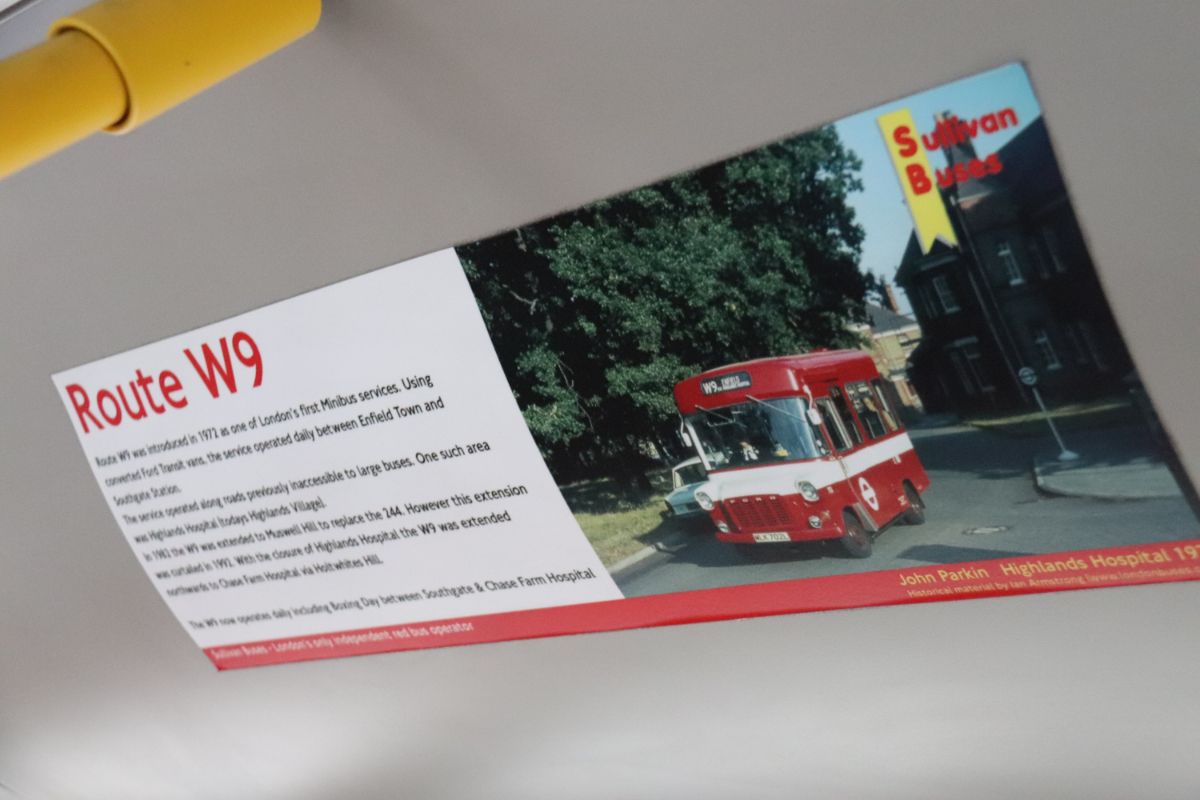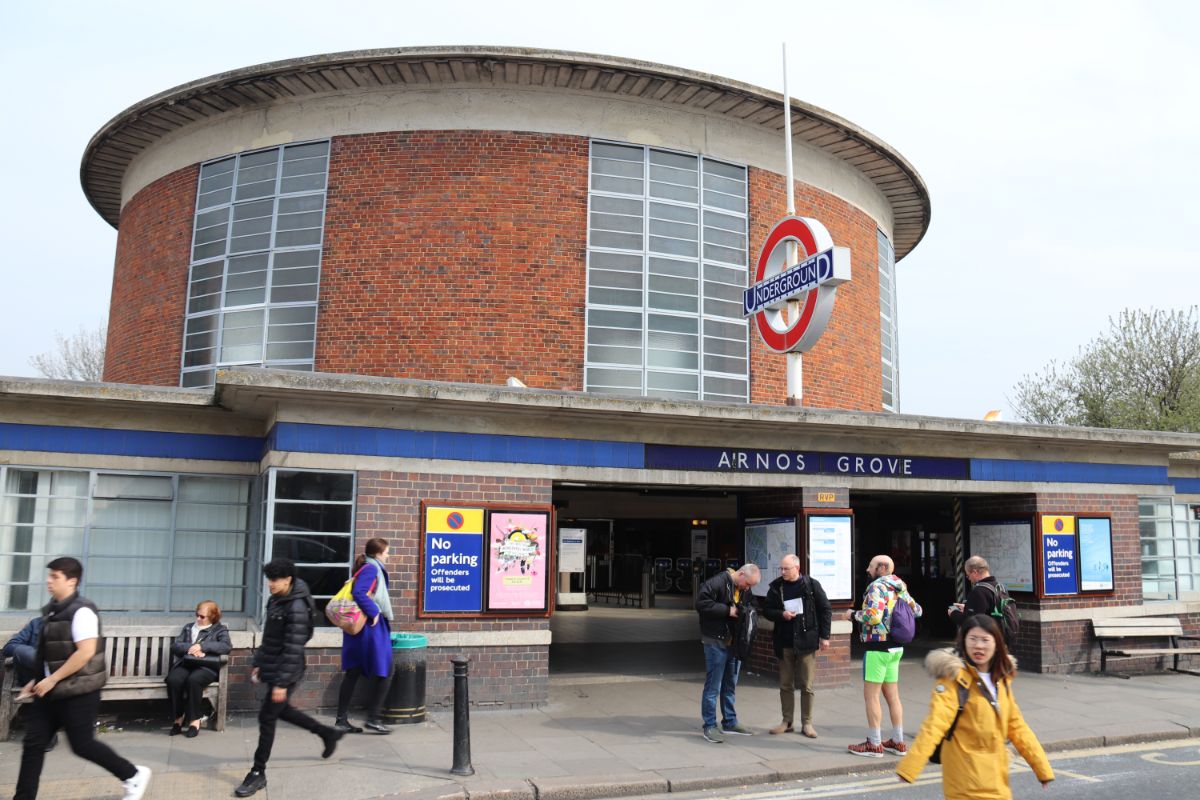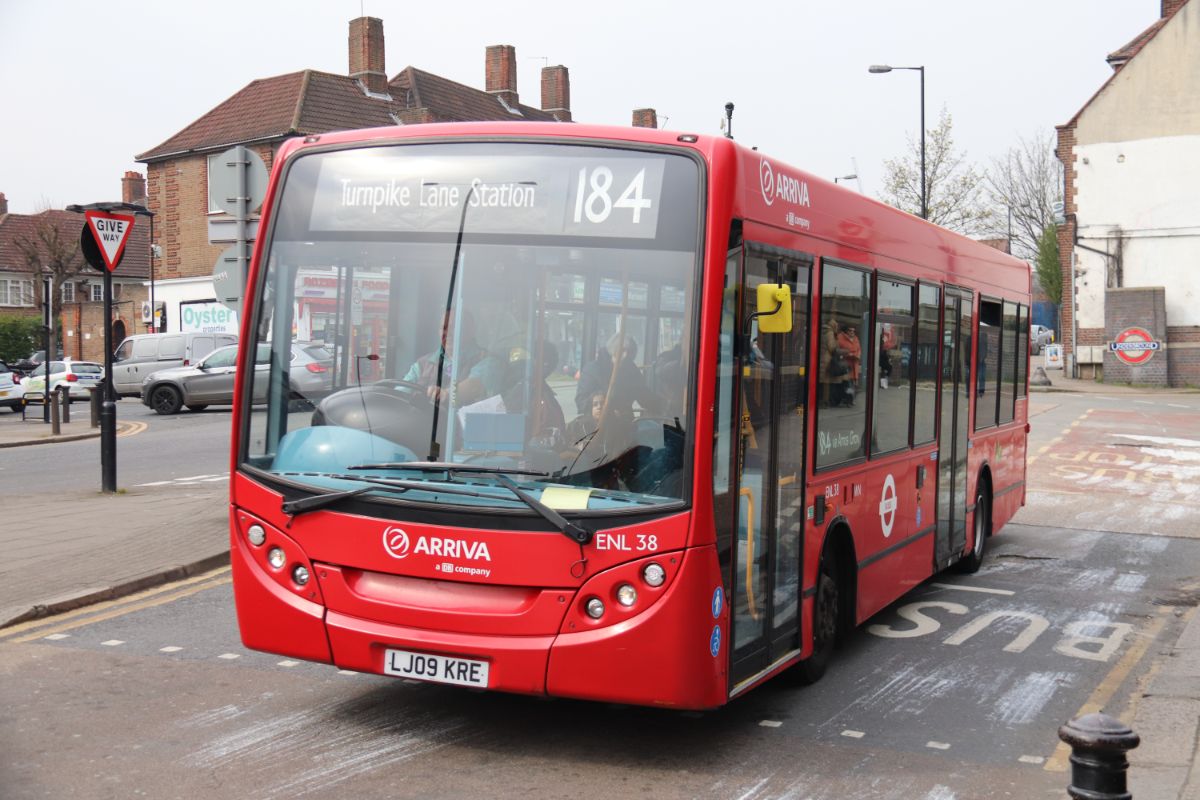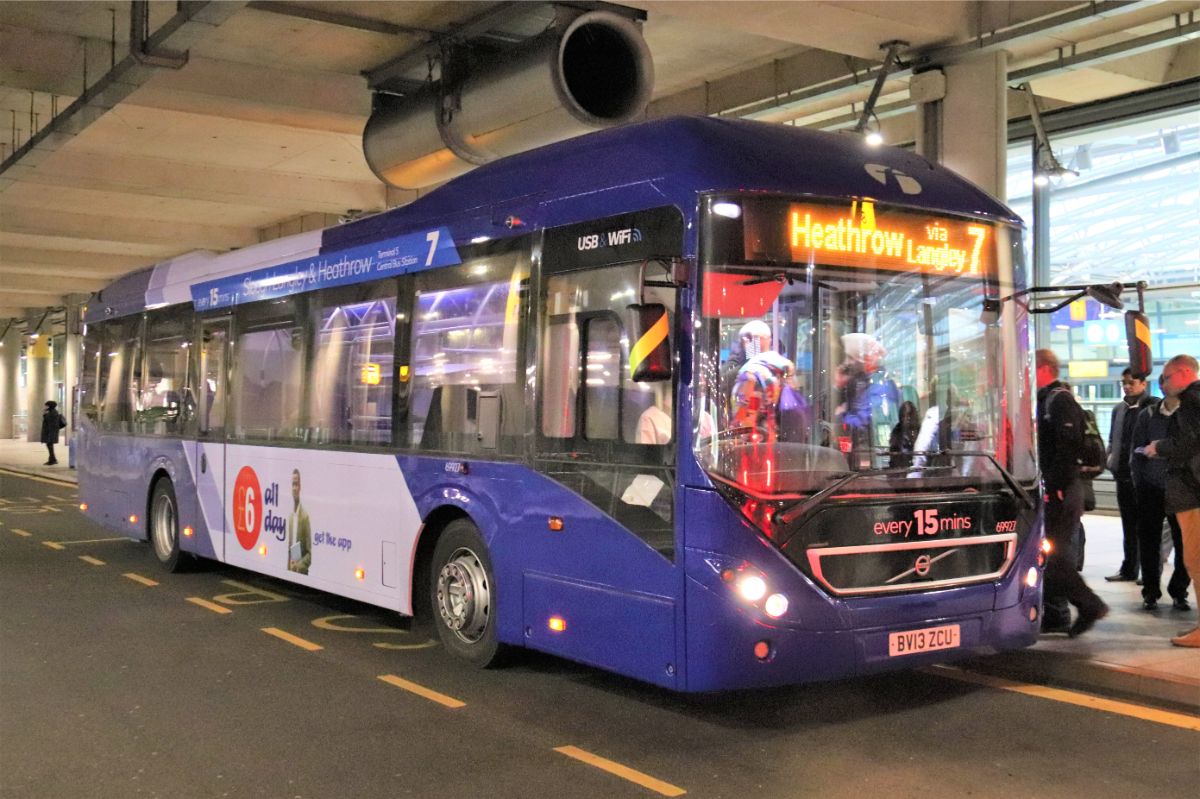The Piccadilly Line…by bus
In their annual bout of bus madness, Founding Editor Stuart Jones and friends take the long way round, getting to Heathrow without simply boarding the Piccadilly Line. Two of the group fell before the first hurdle….
PLEASE NOTE: To see all the images in a gallery, click on the title image above
The objective was straightforward enough, get from Cockfosters to Heathrow following the Piccadilly line. Simple, should take about an hour and a half, except that we decided to do it by TfL bus. From the team that brought you such epics as following the boundary of the old red and country areas by bus and crossing every TfL bus served bridge in a day, this latest challenge turned out to be a deceptively daunting one. The first hurdle was choosing a date when the eight who originally signed up for the trip could make it; this evolved to be Tuesday April 16th, starting at 10am, which seemed ideal at the time. Roger French went to great lengths to plan a route that enabled us to visit (or in some cases see as we passed) every Piccadilly Line station, a process that becomes difficult in places as some have little or no visual presence above ground. He estimated that, with time for lunch and the occasional Costa stop, we aught to have it cracked by around 8pm or so.
I can’t remember why it was we settled on following the Piccadilly line rather than some other jaunt but it suited me because of all the tube lines it is the one I know best from years of parking at Cockfosters and catching it into London for various editorial missions, though I had never ventured beyond the centre to Heathrow and certainly not to Terminal 5 which hadn’t been built when most of my trips were made. So, having seen the subterranean downside of the line, I was now going to see the architectural upside.
This is probably a good place for a paragraph on the history of the railway line, which developed rather than being built in its entirety at one go. What became the Piccadilly Line opened in 1906 as the Great Northern, Piccadilly & Brompton Railway linking Finsbury Park with Hammersmith. A branch from Holborn to Aldwych (originally Strand) opened the following year. In the 1930s the line was extended northwards reaching Cockfosters by July 1933. At the southern end of the line it extended in two directions splitting at Acton Town to head north to first South Harrow (1932) and then Uxbridge (1933) where it took over the District Line services. At the same time, it headed westwards to Northfields (1932) and then Hounslow West (1933). A feature of the 1930s extensions is that the stations were designed with buildings by Charles Holden. With the growing importance of Heathrow Airport, Hatton Cross opened in 1975, Heathrow Central (now Heathrow Terminals 2&3) in 1977 and in 1984 a one-way loop was added to serve Terminal 4. The full extent was reached in 2008 when a station serving the new Terminal 5 opened. The complete line has more stations (53) than any line other than the District Line and only the Central Line is longer than the Piccadilly’s 44 miles. Thanks to Wikipedia for most of that.
Close call
We didn’t get off to a very good start. The night before Andrew Braddock emailed the rest of the part to say that the person in the flat above his daughter’s family’s had gone out leaving the tap running and the ceiling had fallen in, so with much regret he was unable to join in. Andrew Garnett had been hoping to be on board for part of the route but the pressures of press day proved too great to permit even partial participation, so we were Andrew-less. For my part, I thought leaving Brighton before 07.00 would leave plenty of time to drive to Cockfosters but en-route became worried that I would not be able to find a space in the car park so decided to park at Heathrow and get the Piccadilly line there instead. Helpfully, a poster on the train encouraged folk to ‘Discover London above the Piccadilly Line’ but this only incorporated 16 blobs for stations and the most northerly attraction depicted was the Furtherfield Gallery at Finsbury Park. As I travelled along and the empty train became very full and then emptied again, it struck home what a lot of stations there were to be covered later in the day. I thought I was cutting it fine as I charged up the stairs at 10.04 to meet Roger, Mike Best, Peter Bradley and Ray Stenning (in stylish underground moquette pattern trainers), but at 10.07. just as the Sullivan Buses 299 at the terminus on opposite side of the road pulled off from its stand and made a U-turn to pick us up, Bill Hiron burst out of the station entrance and completed our line-up.
Having lost my Oystercard (one of those nice 2014 Year of the Bus special edition ones) on an earlier trip to the capital, paying on a TfL bus using my bank debit card was a first for me. My confidence that it would work had increased when the plastic had got me through the ticket barriers at Heathrow without a hiccup, and better still out of the station at Cockfosters, and sure enough it did work, all day, though I felt a bit vulnerable getting my wallet out repeatedly. This first bus of the day was a dual door 2017 Wright StreetLite DF and we didn’t stay on it long because as we turned right into Reservoir Road, a Hail and Ride stop, we alighted, the driver giving a cheery wave as he drove off.
Reservoir Road is but a short walk from Oakwood Station which is in the simple but nevertheless elegant style developed by Holden shows that public buildings can look good as well as serving their purpose well. There was time to look around it and even use the facilities once a 20p piece had been found to unlock the door. New to me was the fact that within every Underground Station you will find displayed somewhere a tile depicting a maze. Every one of them is different and numbered. Arnos Grove’s is number 219 of 270.
There wasn’t long to wait for the 121 to Southgate, operated by Arriva using a Wright Pulsar bodied DAF DB250, and while doing so there was chance to photograph not only the station but buses calling in on the 377.
Everyone other than me on the trip was steeped in decades of London Transport history, and here one of the nuggets was that neither the 121 nor the 299 appeared on Bill’s 1976 London Transport map in the same form. I learned that the 121 was once a short route between Chingford and Enfield that was linked to a Turnpike Lane to Oakwood route to give a cross-Oakwood service.
Southgate, another Holden station, has a circular main building, much lower than that at Oakwood, with a bus station around half of its circumference. Originally buses were only able to use it in one direction but now it is bi-directional. Roger and Bill reminisced about one of the first Beatties model shops which used to be over the road but has long since disappeared. Interesting survivors in the same locations were two banks belonging to HSBC and NatWest respectively, which had originally been the Midland and the National Provincial.
Onward to Arnos Grove, we boarded a Sullivan Buses 298 which had a cove panel display detailing the history of the 298 and 299 which didn’t used to go to Arnos Grove but has since the late 1980s. Another panel told the story of the W9, the subject of one of LT’s first minibus experiments utilising converted Ford Transits with sliding doors. Our 298, a 2011 ADL Enviro200, was infinitely preferable, even though it had oily fitters hand marks in evidence on the roof panels. Similar presentational failures were evident on our next bus, another Enviro200 but this time from the Arriva London fleet operating the 184 to take us from Arnos Grove to Bounds Green. The 184 is another service that originates from the 1980s, having previously been the 84A briefly. The number 184 had previously been used on a South London route. Roger pointed out that we could have stayed on the 299 we first caught as it crosses the North Circular Road on which we were travelling, but had not done so because it would have meant missing out Arnos Grove.
Bounds Green Station is both typically Holden and also distinctive, being more angular and located on a corner plot. We switched to another Wright bodied Arriva double decker on the 221 heading for Turnpike Lane, passing Wood Green Station, which has an underground turn back siding between the tracks at the northern end of the platforms. A little before this on the right is Arriva’s Wood Green bus garage, once a trolleybus depot. Until the late 1980s Wood Green had another, more famous, bus garage belonging to Eastern National where the utterly politically incorrect ‘On the Buses’ programme was filmed. It was so popular it spawned three spin-off movies.
Once a bendibus route, the 29 taking us from Turnpike Lane to Finsbury Park passing the rather modest Manor House Station was another Arriva Wright product, this time on a Volvo chassis. The building still stands. In a hint of what was to come, the signs indicated that this service was only running to Tottenham Court Road rather than Trafalgar Square. Manor House was also once the home of one of LT’s divisional offices and following the break up of the bus operations became the headquarters of Leaside. Ray pointed out that Finsbury Park backwards is krapyrubsnif and also revealed that Virginia Bottomley is an anagram; of what I will leave you to work out.
Unusually, Arsenal Station, is not on a TfL bus route and it was always our intention to walk from Finsbury Park to Holloway Road to take it in. Arsenal Station’s appearance is unusual in that its plain cream painted façade, with huge Underground roundel, sits in a row of private houses. It always intrigued me that the fine original tiling on the station’s platform walls reads Gillespie Road rather than Arsenal, and now I realized why as our walk took us the length of it, passing the rear of the impressive Emirates stadium I usually see from the other side when approaching London on the East Coast main line. To say the area is not served by TfL buses is not entirely true as we saw several of the latest Dial-a-Ride Volkswagen Mellor minibuses, before passing Drayton Park railway station. This looks really handy for fans visiting the Emirates Stadium but unfortunately the limited platform size dictates its closure for safety reasons when matches are on. We had assumed there would be a more obvious way to get back on our intended route but this proved not to be the case and we went somewhat off course, utilising a Metroline ADL Enviro 400 on the 263 heading to Barnet Hospital to get us to the deep maroon tiles and arched windows of Holloway Road Station. Transferring to another Metroline Wright Volvo on the 17 we headed to Kings Cross via the similarly tiled Caledonian Road Station.
There was growing feeling among the party that lunchtime was approaching. Ray said he knew some nice places at the rear of Kings Cross at which Bill expressed concern over what Ray’s definition of a ‘nice place’ might mean, so we opted for one of the eateries overlooking the multi-tubular roof structure of the railway terminal.
So far so good, but now we were about to encounter delays for which TfL was in no way responsible in the shape of the climate change protestors of Extinction Revolution who had successfully brought central London to a standstill. I cannot but share their concern for the planet but I wish they’d picked a different time and place to demonstrate it.
Leaving Kings Cross we sought a 91 but a yellow jacket over the St Pancras International Station stop A informed us the stop was closed, forcing us to walk on, missing a passing 91 in the process. Also closed was stop W which hosts the 748 service. Peter explained this was an amazing survivor, a derivative of the Green Line 758 service from Hemel Hempstead that offers one return journey a day via the city. Quite why it warranted a stop to itself and 10 services were listed on stop A defeated me. Ray was understandably critical of a notice on stop A that informed of changes to services 10 and 23 from the previous Saturday 24 November, as the 23 didn’t stop there anyway. When we did find an open stop, we faced our longest wait of the day, a full 12 minutes, though when Roger checked on Matthew Somerville’s ‘Live London Bus Map’, buses were due in 3, 4, 5, 7, and 8 minutes. When one did arrive, it was a Holloway allocated Borismaster from the Metroline fleet. Does anybody still call them the New Bus for London?
We got off at Holborn, having passed Russell Square on the way and then walked as intended via Covent Garden, Leicester Square and Piccadilly Circus, where it was evident that the roads were very quiet. Appropriately, Piccadilly is also the name of the road that runs from Piccadilly Circus down to Green Park Station, indeed it is where the line’s name comes from as the tracks run underneath it. It felt rather weird as we walked down the middle of the tarmac without a vehicle in site, declining the possibility of tea at the Ritz in favour of ‘pressing on’. We were to have caught the 14 from Piccadilly Circus to South Kensington and the 74 from there to Earl’s Court, but there weren’t any to catch. At Green Park a vote was taken and, on the basis of Roger gleaning from the TfL website that inbound buses were being turned at South Kensington, and we had planned to walk from Earls Court to Hammersmith anyway, the decision was made to catch the Underground to Hammersmith. Thus, we didn’t see the street level splendours of Hyde Park Corner, Knightsbridge, South Kensington, Gloucester Road, Earl’s Court or Baron’s Court. Maybe we’ll go back one day and do it properly.
Back above ground, prominent signs in the bus station showed the alternative locations of stops while Hammersmith Bridge was closed. It was 15.13, and we boarded a Metroline ADL Enviro400 on the 266 to Acton Town Hall where we availed ourselves of a local coffee shop’s offerings. Once upon a time the 266 was the 666 trolleybus route and remains notable, according to Ray, for passing the headquarters of the Best Impressions empire at 15 Starfield Road. Acton Town Station is another Holden design and has the London Transport Museum’s reserve collection just up the road.
From Acton Town our steed for the E3 was a rather rattly Enviro400 from RATP’s London United fleet, a bus that had been new to First. It took us past the end of the road that South Ealing Station is on and on to the impressive Northfields station, where we switched to the E2. This was a Metroline Wright Volvo dating from 2010 that showed the benefit of mid life refurbishments, especially when using an attractive moquette and kept as clean as this was. It was noticeable that there were several modern single deckers operating in the area that were not part of the TfL network, with Enviro200s provided by National Express for the University of South London in a silver livery, and a 68 plate Wright StreetLite belonging to Passenger Plus showing Brentford – Northfields on the destination.
Alighting at a request stop just beyond the A4 Great West Road, we walked around the corner to a stop called Windmill Road in the shadow of Hammersmith flyover. The once clear roof of the shelter had so much ingrained dirt from the overhanging trees above that it looked filthy and a solid roof would have been more attractive. Roger tried to find out when our next bus, an H91, would arrive, but was hampered because TfL’s own website only gave details for a different Windmill Road. He overcame this by entering it on route H91 which said one minute.
Rather confusingly, the Wright bodied Volvo on the H91 showed London Sovereign on the front and London United on the side. Dating from 2018, making it the newest bus we travelled on, it had a lot of upper deck legroom and was very tidy. I photographed it arriving, as I had done nearly every other bus, and when I boarded the driver asked rather accusingly whether he was in the picture. I assured him I photographed buses not drivers, but it spoiled the otherwise positive customer impression of this leg of the journey.
The route took us past a special bus only road at Northumberland Avenue, previously used by short runs of the H91. Still marked as bus-only it has had no actual bus service for some years. We could have changed bus to go past Boston Manor but instead we stayed on the H91. We just saw the top of the old Osterley and Spring Grove Station, disused since the early 1930s, as well as the new Osterley created by Holden. The old Osterley isn’t the only Piccadilly Line station to have gone, York Road, Brompton Road and Down Street have disappeared from the network too. There has been talk of reopening York Road as a second Kings Cross stop.
The original plan would have seen us catch the 111 from Osterley to Hounslow Bus Station taking in Hounslow East Station followed by a walk to Hounslow Central, but instead we carried on to Hounslow West. One reason was the increasing frustration that every time Roger calculated the connections, the driver would stop and inform everyone that he had been instructed to wait to ‘regulate the timetable’. Nobody likes this ‘we’re going to make you wait and late because it suits us,’ attitude and it is really time that TfL abandoned the Dark Ages and got a bit more customer friendly in this respect. All of this internet use to check timetables and bus locations takes a heavy toll on batteries over the course of the day but you couldn’t charge a phone on any of the TfL services we used. I’m had thought the only buses with them were the ADL/BYDs on the 507 and 521 services out of Waterloo, which, with the short duration of most passenger journeys on them, is probably the least appropriate place to trial something that is becoming much more familiar outside the capital. Leon Daniels often joked that the USB points were only fitted on them to supplement the vehicle’s batteries from people’s mobiles. I have since learned that USBs are also installed on the electric Enviro 200MMCs on route 153 between Moorgate and Finsbury Park and have been retrofitted on the refurbished deckers on the long X26 Heathrow to East Croydon route.
One bus sufficed to cover the next three stations somewhat swiftly as the 482 took us to Terminal 5 passing Hatton Cross and Terminal 4 on the way, although there is no separate overground building at Terminal 4, which is also the only Piccadilly Line station with only one platform. At Hatton Cross Station we were joined on our Metroline Enviro400 by James Wake from the RATP Dev London schedules team at Fulwell. He had been following our exploits via Roger’s twitter feed.
You can’t catch a TfL bus between Terminals 5 and 2/3 (though there is the 423 to Bath Road) but there is the 7 which First Berkshire operates with newly refurbished Volvo 7700 hybrids. Ray is very proud of what has been achieved with these buses having had something to do with it, and I have to say this was by far the most imaginative saloon we travelled in all day. Better still, as part of Freeflow Heathrow it is free.
All that remained was to say our goodbyes, a ride on an Airparks Scania to collect my car and the drive north to Stamford, the cost of the car parking being more than the total cost of the day’s travel; the latter a bargain, the former a rip-off.
Last word
There is an argument that even our original plan rather neglected the Acton Town to Uxbridge section of the Piccadilly Line, so were I to try it again I might be inclined to set aside two days and cover all the lines either side of Hammersmith on separate days and at a more leisurely pace.
As on previous occasions, though there were elements worthy of criticism TfL’s remains a massively impressive and efficient network.
Ray is pretty determined that our next jaunt should have a Green Line angle and to this end I have acquired 1960s Green Line and London Country route maps at antique events in recent weeks. On the other hand, Andrew Braddock, who’s daughter’s roof is now fully repaired, still hankers after retracing the wires of the trolleybuses that I never saw in action because the last of them disappeared in 1962. However, I have seen one of the trolleybuses; as far as I am aware it is still sitting outside the municipal bus depot in the Spanish city of Zaragoza. Whatever we do, it will no doubt generate surprisingly little consternation on the faces of the drivers concerned as half a dozen or so supposed adults descend on their vehicles. They’ve seen much odder.

